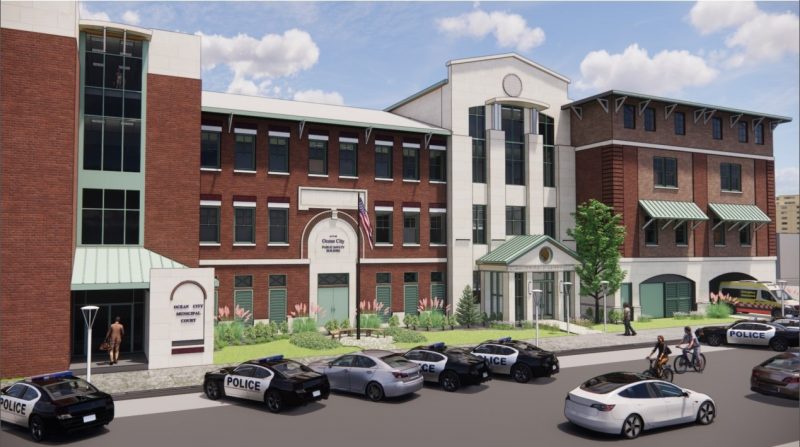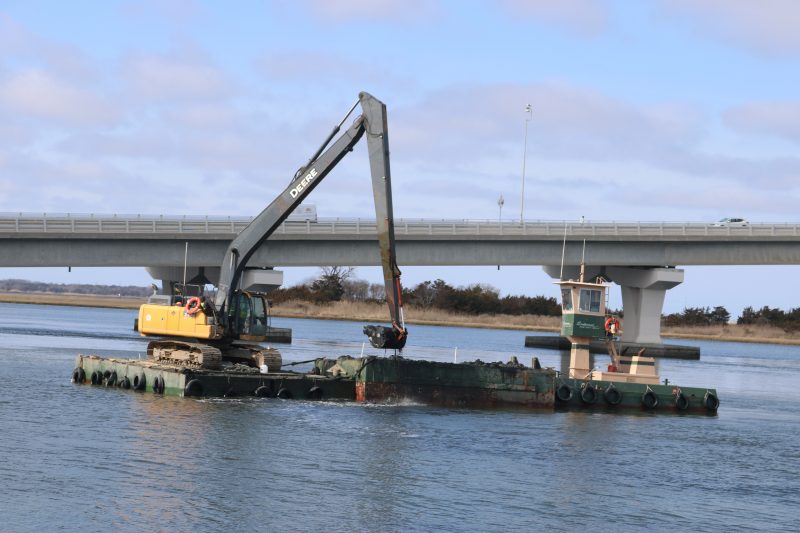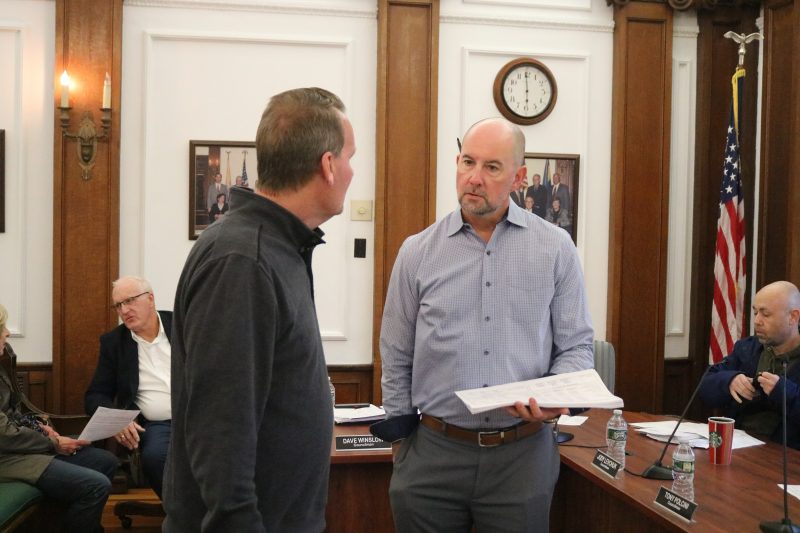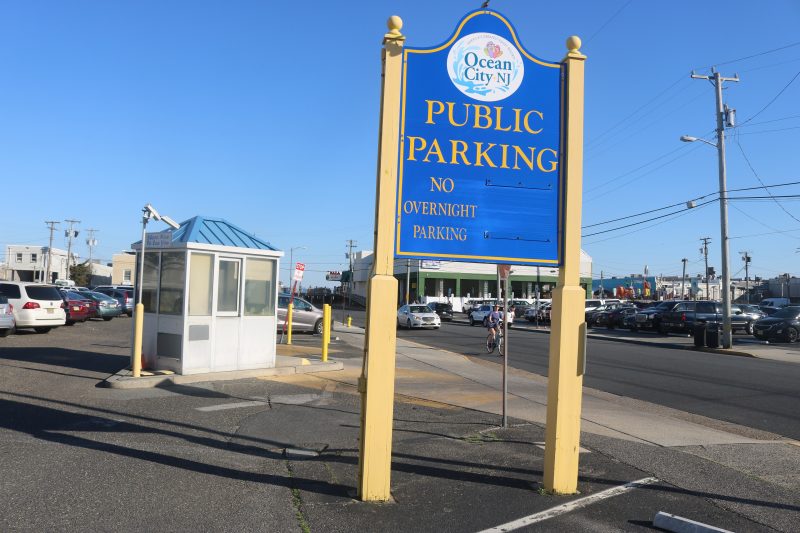City Council approves the capital plan by a 5-0 vote.
 By DONALD WITTKOWSKI
By DONALD WITTKOWSKI
Ocean City’s Boardwalk, roads, police facilities and more will be improved under a nearly $160 million capital plan that also includes flood-mitigation projects to protect low-lying neighborhoods from stormwater.
City Council voted 5-0 Thursday night to formally approve the capital plan, a sweeping blueprint proposed by Mayor Jay Gillian’s administration for construction projects and civic improvements across the island in the next five years.
“We’ve been doing it for 14 years. We’ve been doing what has to be done. Everything is budgeted responsibly,” Gillian said of his administration’s experience in putting together capital plans since he first became mayor in 2010.
Gillian stressed in an interview after the Council meeting that the capital plan is a planning tool to guide the city’s spending for construction projects and other improvements for the next five years. He noted that it is flexible and can be changed when needed.
Councilman Dave Winslow also emphasized that the capital plan is flexible. He said city officials should scrutinize the plan each year to decide which projects are needed and should be prioritized.
“I think the capital plan is a plan – not an etched-in-stone type of thing,” Winslow said.
Overall, the capital plan proposes $159.4 million in spending from 2024 to 2028. The bulk of the spending, about $67 million worth, will be done in 2024 for a series of major projects, including a $30 million renovation and expansion of the city’s antiquated public safety building.

City Council approves the capital plan by a 5-0 vote.
During a presentation on the capital plan at the March 28 Council meeting, city officials unveiled a new architectural rendering that depicts what the renovated public safety building will look like when finished. The presentation can be found
here.
The public safety building is more than a century old and formerly was a school before it was converted into the police station. The building will be given an extensive renovation and expanded on the south side, city officials said.
Construction work on the public safety building is expected to begin in 2025 and may be completed by late 2026, the city’s Chief Financial Officer Frank Donato said earlier.
Separately, the capital plan also includes the construction of a $6.5 million police substation on the Boardwalk at Eighth Street. The city plans to begin construction in 2024 on the substation and finish it by early 2025.
Once the substation is completed, the police department’s patrol units will temporarily move into the facility to allow renovations to begin on the public safety building. The police department’s administrative staff will occupy other municipal offices in town, Donato said.
The police department is led by Chief Bill Campbell, a 30-year veteran. In a separate vote Thursday, Council approved an employment contract with Campbell that sets his salary at $216,911. His salary will increase annually at the same percentage as the raises given to members of the police department’s labor union, PBA Local 61, the contract says.

Dredging projects are a major part of the city's capital improvement program.
Renovation of the public safety building is the single-most expensive project in the capital plan, but there are other big-ticket items costing in the millions of dollars for 2024 and later years.
The northern part of the Boardwalk will be widened and strengthened from St. James Place to Fifth Street this year. The city will use a $4.8 million state grant to help pay for the nearly $10 million project.
Along the back bay, the city will continue its annual dredging program to clear out channels and lagoons clogged with muddy sediment to make them navigable for boat traffic. The capital plan proposes spending $2 million in 2024 for dredging and another $2 million or $3 million annually from 2025 to 2028 to continue the program.
Road construction and flood-mitigation projects are another major piece of the capital plan as the city looks to protect low-lying neighborhoods from stormwater. Starting in 2025, the capital plan proposes annual spending of $7 million for road, drainage and flood-control projects.
One area the city will focus on this year for flood mitigation is the West Avenue corridor from Ninth Street to 26th Street. Stormwater pumping stations and road reconstruction are part of the project.
Another major flood-control project is planned for the Merion Park neighborhood in the south end of town. A combination of city, county and federal funding will pay for the $10.7 million project.
The city will partner with Cape May County for a series of stormwater-protection measures along the 34th Street entryway and Merion Park. The project will include stormwater pumping stations and elevating the roadway.

Chief Financial Officer Frank Donato, right, holds a copy of the proposed 2024 municipal budget while talking to Mayor Jay Gillian.
In another major vote Thursday, Council introduced the city’s proposed $113.6 million municipal budget for 2024. A public hearing and final vote on the budget are scheduled for the May 9 Council meeting.
The budget originally was for $110.1 million, but two grants recently came in to increase the total amount to $113.6 million, Donato said. The bulk of the grant money is a $3.5 million grant from the Federal Emergency Management Agency to help Ocean City elevate more homes to protect them from flooding.
The budget includes a 3.7-cent increase in the local tax rate. The tax increase means that the owner of an average Ocean City home assessed at $650,000 will pay an extra $241 annually for local property taxes, Donato said during a budget presentation at the March 28 Council meeting.
Mounting expenses for city salaries, pensions, healthcare, liability insurance and trash collection are among the primary reasons why the budget is higher than the 2023 spending plan, Donato explained.
Winslow said “none of us” wants to see a tax increase. But he pointed out that about half of the budget spending is for fixed costs such as salaries, giving the city little “wiggle room” to make adjustments to reduce expenses.
“We just need to manage all of the other expenses,” he said of the budget spending.
The city will use $6 million of its $11.4 million surplus to help pay for the budget. The remaining $5.4 million in surplus funding will be kept in reserve in case there are emergencies or unforeseen expenses in the future.
The city also benefits from its growing tax base, a sign that the local real estate market remains strong, Donato said. More than $200 million in assessed value was added this year, raising the city’s total tax base to $12.7 billion.
Also helping to pay for the budget is the city’s array of revenue sources, including beach tag sales, parking charges and construction code fees. Beach tag sales and parking fees are expected to generate about $5.8 million and $4 million, respectively, in revenue this year, the budget shows.

Helping to fund the budget is an estimated $4 million in parking revenue for 2024.
 By DONALD WITTKOWSKI
Ocean City’s Boardwalk, roads, police facilities and more will be improved under a nearly $160 million capital plan that also includes flood-mitigation projects to protect low-lying neighborhoods from stormwater.
City Council voted 5-0 Thursday night to formally approve the capital plan, a sweeping blueprint proposed by Mayor Jay Gillian’s administration for construction projects and civic improvements across the island in the next five years.
“We’ve been doing it for 14 years. We’ve been doing what has to be done. Everything is budgeted responsibly,” Gillian said of his administration’s experience in putting together capital plans since he first became mayor in 2010.
Gillian stressed in an interview after the Council meeting that the capital plan is a planning tool to guide the city’s spending for construction projects and other improvements for the next five years. He noted that it is flexible and can be changed when needed.
Councilman Dave Winslow also emphasized that the capital plan is flexible. He said city officials should scrutinize the plan each year to decide which projects are needed and should be prioritized.
“I think the capital plan is a plan – not an etched-in-stone type of thing,” Winslow said.
Overall, the capital plan proposes $159.4 million in spending from 2024 to 2028. The bulk of the spending, about $67 million worth, will be done in 2024 for a series of major projects, including a $30 million renovation and expansion of the city’s antiquated public safety building.
By DONALD WITTKOWSKI
Ocean City’s Boardwalk, roads, police facilities and more will be improved under a nearly $160 million capital plan that also includes flood-mitigation projects to protect low-lying neighborhoods from stormwater.
City Council voted 5-0 Thursday night to formally approve the capital plan, a sweeping blueprint proposed by Mayor Jay Gillian’s administration for construction projects and civic improvements across the island in the next five years.
“We’ve been doing it for 14 years. We’ve been doing what has to be done. Everything is budgeted responsibly,” Gillian said of his administration’s experience in putting together capital plans since he first became mayor in 2010.
Gillian stressed in an interview after the Council meeting that the capital plan is a planning tool to guide the city’s spending for construction projects and other improvements for the next five years. He noted that it is flexible and can be changed when needed.
Councilman Dave Winslow also emphasized that the capital plan is flexible. He said city officials should scrutinize the plan each year to decide which projects are needed and should be prioritized.
“I think the capital plan is a plan – not an etched-in-stone type of thing,” Winslow said.
Overall, the capital plan proposes $159.4 million in spending from 2024 to 2028. The bulk of the spending, about $67 million worth, will be done in 2024 for a series of major projects, including a $30 million renovation and expansion of the city’s antiquated public safety building.
 City Council approves the capital plan by a 5-0 vote.
During a presentation on the capital plan at the March 28 Council meeting, city officials unveiled a new architectural rendering that depicts what the renovated public safety building will look like when finished. The presentation can be found here
City Council approves the capital plan by a 5-0 vote.
During a presentation on the capital plan at the March 28 Council meeting, city officials unveiled a new architectural rendering that depicts what the renovated public safety building will look like when finished. The presentation can be found here Dredging projects are a major part of the city's capital improvement program.
Renovation of the public safety building is the single-most expensive project in the capital plan, but there are other big-ticket items costing in the millions of dollars for 2024 and later years.
The northern part of the Boardwalk will be widened and strengthened from St. James Place to Fifth Street this year. The city will use a $4.8 million state grant to help pay for the nearly $10 million project.
Along the back bay, the city will continue its annual dredging program to clear out channels and lagoons clogged with muddy sediment to make them navigable for boat traffic. The capital plan proposes spending $2 million in 2024 for dredging and another $2 million or $3 million annually from 2025 to 2028 to continue the program.
Road construction and flood-mitigation projects are another major piece of the capital plan as the city looks to protect low-lying neighborhoods from stormwater. Starting in 2025, the capital plan proposes annual spending of $7 million for road, drainage and flood-control projects.
One area the city will focus on this year for flood mitigation is the West Avenue corridor from Ninth Street to 26th Street. Stormwater pumping stations and road reconstruction are part of the project.
Another major flood-control project is planned for the Merion Park neighborhood in the south end of town. A combination of city, county and federal funding will pay for the $10.7 million project.
The city will partner with Cape May County for a series of stormwater-protection measures along the 34th Street entryway and Merion Park. The project will include stormwater pumping stations and elevating the roadway.
Dredging projects are a major part of the city's capital improvement program.
Renovation of the public safety building is the single-most expensive project in the capital plan, but there are other big-ticket items costing in the millions of dollars for 2024 and later years.
The northern part of the Boardwalk will be widened and strengthened from St. James Place to Fifth Street this year. The city will use a $4.8 million state grant to help pay for the nearly $10 million project.
Along the back bay, the city will continue its annual dredging program to clear out channels and lagoons clogged with muddy sediment to make them navigable for boat traffic. The capital plan proposes spending $2 million in 2024 for dredging and another $2 million or $3 million annually from 2025 to 2028 to continue the program.
Road construction and flood-mitigation projects are another major piece of the capital plan as the city looks to protect low-lying neighborhoods from stormwater. Starting in 2025, the capital plan proposes annual spending of $7 million for road, drainage and flood-control projects.
One area the city will focus on this year for flood mitigation is the West Avenue corridor from Ninth Street to 26th Street. Stormwater pumping stations and road reconstruction are part of the project.
Another major flood-control project is planned for the Merion Park neighborhood in the south end of town. A combination of city, county and federal funding will pay for the $10.7 million project.
The city will partner with Cape May County for a series of stormwater-protection measures along the 34th Street entryway and Merion Park. The project will include stormwater pumping stations and elevating the roadway.
 Chief Financial Officer Frank Donato, right, holds a copy of the proposed 2024 municipal budget while talking to Mayor Jay Gillian.
In another major vote Thursday, Council introduced the city’s proposed $113.6 million municipal budget for 2024. A public hearing and final vote on the budget are scheduled for the May 9 Council meeting.
The budget originally was for $110.1 million, but two grants recently came in to increase the total amount to $113.6 million, Donato said. The bulk of the grant money is a $3.5 million grant from the Federal Emergency Management Agency to help Ocean City elevate more homes to protect them from flooding.
The budget includes a 3.7-cent increase in the local tax rate. The tax increase means that the owner of an average Ocean City home assessed at $650,000 will pay an extra $241 annually for local property taxes, Donato said during a budget presentation at the March 28 Council meeting.
Mounting expenses for city salaries, pensions, healthcare, liability insurance and trash collection are among the primary reasons why the budget is higher than the 2023 spending plan, Donato explained.
Winslow said “none of us” wants to see a tax increase. But he pointed out that about half of the budget spending is for fixed costs such as salaries, giving the city little “wiggle room” to make adjustments to reduce expenses.
“We just need to manage all of the other expenses,” he said of the budget spending.
The city will use $6 million of its $11.4 million surplus to help pay for the budget. The remaining $5.4 million in surplus funding will be kept in reserve in case there are emergencies or unforeseen expenses in the future.
The city also benefits from its growing tax base, a sign that the local real estate market remains strong, Donato said. More than $200 million in assessed value was added this year, raising the city’s total tax base to $12.7 billion.
Also helping to pay for the budget is the city’s array of revenue sources, including beach tag sales, parking charges and construction code fees. Beach tag sales and parking fees are expected to generate about $5.8 million and $4 million, respectively, in revenue this year, the budget shows.
Chief Financial Officer Frank Donato, right, holds a copy of the proposed 2024 municipal budget while talking to Mayor Jay Gillian.
In another major vote Thursday, Council introduced the city’s proposed $113.6 million municipal budget for 2024. A public hearing and final vote on the budget are scheduled for the May 9 Council meeting.
The budget originally was for $110.1 million, but two grants recently came in to increase the total amount to $113.6 million, Donato said. The bulk of the grant money is a $3.5 million grant from the Federal Emergency Management Agency to help Ocean City elevate more homes to protect them from flooding.
The budget includes a 3.7-cent increase in the local tax rate. The tax increase means that the owner of an average Ocean City home assessed at $650,000 will pay an extra $241 annually for local property taxes, Donato said during a budget presentation at the March 28 Council meeting.
Mounting expenses for city salaries, pensions, healthcare, liability insurance and trash collection are among the primary reasons why the budget is higher than the 2023 spending plan, Donato explained.
Winslow said “none of us” wants to see a tax increase. But he pointed out that about half of the budget spending is for fixed costs such as salaries, giving the city little “wiggle room” to make adjustments to reduce expenses.
“We just need to manage all of the other expenses,” he said of the budget spending.
The city will use $6 million of its $11.4 million surplus to help pay for the budget. The remaining $5.4 million in surplus funding will be kept in reserve in case there are emergencies or unforeseen expenses in the future.
The city also benefits from its growing tax base, a sign that the local real estate market remains strong, Donato said. More than $200 million in assessed value was added this year, raising the city’s total tax base to $12.7 billion.
Also helping to pay for the budget is the city’s array of revenue sources, including beach tag sales, parking charges and construction code fees. Beach tag sales and parking fees are expected to generate about $5.8 million and $4 million, respectively, in revenue this year, the budget shows.
 Helping to fund the budget is an estimated $4 million in parking revenue for 2024.
Helping to fund the budget is an estimated $4 million in parking revenue for 2024.